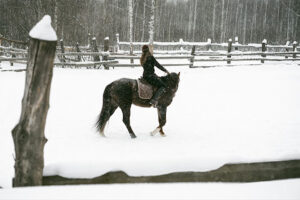Winter Hoof Care: Prevent Cracks and Cold-Related Issues
When the temperature drops and snow starts falling, your horse’s hooves face a whole new set of challenges. Winter brings mud, ice, and bitter cold that can wreak havoc on those hard-working hooves. But don’t worry—with the right approach to winter hoof care, you can keep your equine friend comfortable and sound all season long. […]

When the temperature drops and snow starts falling, your horse’s hooves face a whole new set of challenges. Winter brings mud, ice, and bitter cold that can wreak havoc on those hard-working hooves.
But don’t worry—with the right approach to winter hoof care, you can keep your equine friend comfortable and sound all season long.
How Does The Winter Affect Horse Hoof Care
Cold weather affects horse hooves in ways that might surprise you. The combination of freezing temperatures, wet conditions, and icy ground creates the perfect storm for hoof problems.
Hooves can become brittle and prone to cracking when exposed to harsh winter elements. At the same time, standing in muddy paddocks or damp stalls softens the hoof wall, making it vulnerable to bacterial infections like thrush.
Here’s something else to keep in mind: hoof growth naturally slows down during winter months. This means any cracks or damage that develop won’t grow out as quickly as they would in warmer weather. That’s why being proactive about equine winter hoof health is so important.
Also Read: The Complete Guide to Hoof Boot Fitting (and Common Mistakes to Avoid)
A Few Hoof Care Tips To Remember
- Daily Cleaning Makes All the Difference
Think of daily hoof picking as your first line of defense in horse hoof care in winter. Even if you’re not riding regularly during the cold months, taking a few minutes each day to clean your horse’s hooves pays huge dividends.
Grab your hoof pick and carefully remove any packed snow, ice balls, mud, and debris from the sole and frog area. Those ice balls aren’t just uncomfortable—they can cause serious bruising and make your horse slip.
Packed mud harbors bacteria that lead to thrush, which you’ll recognize by its characteristic foul smell and black discharge.
While you’re cleaning, take a moment to really look at each hoof. Check for any new cracks in the hoof wall, chips along the edges, or soft spots that weren’t there before. Early detection is your best friend when it comes to preventing small issues from becoming big problems.
- Working with Your Farrier Throughout Winter
Regular farrier visits are absolutely essential for winter hoof care. Your farrier should trim your horse’s hooves every six to eight weeks, even during the coldest months. Consistent trimming prevents overgrowth that can lead to cracks and helps maintain proper balance, which distributes weight evenly across the hoof.
If your horse wears shoes, winter is the time to have a conversation with your farrier about specialized options. Snow pads are game-changers for preventing snowballing—that frustrating buildup of packed snow under the hoof.
Rim shoes provide extra traction on icy surfaces, while shoes with borium or studs offer even more grip when conditions get truly treacherous.
Don’t overlook barefoot horses, though. They also need regular trims to maintain healthy soles and walls. A well-maintained barefoot hoof can actually handle winter conditions quite well when properly cared for.
- Mastering Moisture Management
Here’s where winter gets tricky: you need to protect hooves from excess moisture while also preventing them from drying out and cracking. It’s a delicate balance, but totally manageable with the right strategy.
Start with your horse’s living environment. Keep stalls as dry as possible by changing fresh bedding regularly. Standing in wet bedding is one of the fastest ways to deteriorate hoof quality.
If your horse spends time in turnout, try to provide areas with good drainage or use gravel to create dry zones where they can stand.
Hoof sealants and dressings are wonderful tools for protecting hooves from the elements. These products create a barrier that regulates moisture, keeping too much wetness out while preventing excessive drying.
Some people swear by simple petroleum jelly applied to the hoof wall and sole after cleaning. It’s affordable and effective at shielding hooves from mud and urine exposure.
- The Role of Nutrition in Preventing Horse Hoof Cracks
You’ve probably heard the saying that good hooves start from the inside, and it’s absolutely true. A balanced diet rich in the right nutrients supports strong, resilient hooves that can better withstand the challenges of winter.
Biotin is the superstar when it comes to hoof health, promoting strong keratin production. But it doesn’t work alone—methionine, zinc, protein, and various vitamins all play supporting roles in building healthy hoof tissue.
During winter, when fresh grass is limited and hay quality varies, your horse might not be getting optimal nutrition from forage alone. This is where hoof supplements for horses come into play. These specially formulated products fill nutritional gaps and provide concentrated doses of the nutrients hooves need most.
If you’re considering supplements, chat with your veterinarian or an equine nutritionist. They can evaluate your horse’s specific diet and recommend appropriate supplementation based on individual needs.
Also Read: Poultice Vs Liniment: When To Use
- Keeping Horses Active Safely
Regular exercise during winter isn’t just good for your horse’s mind and body—it’s crucial for hoof health too. Movement promotes blood circulation in the lower limbs, which encourages healthy hoof growth and natural repair processes. It also provides natural wear that helps maintain hoof shape between farrier visits.
That said, you need to be smart about winter exercise. Hard, frozen ground can cause excessive concussion that leads to bruising and cracks. Avoid intense activities like galloping or jumping on frozen surfaces. Stick to moderate exercise like walking and easy trotting when conditions allow.
Always check your riding areas for ice patches or other hazards before turning horses out or beginning a ride. Good footing, combined with appropriate shoeing or trimming, keeps everyone safe and sound.
- Shelter and Comfort Considerations
Providing adequate shelter is a key component of hoof care tips for winter. While horses are hardy animals, protection from wind and precipitation helps reduce cold stress and keeps hooves drier. This doesn’t necessarily mean keeping horses stalled 24/7—many do beautifully with access to a run-in shed or windbreak.
Inside or outside, dry bedding is essential. Horses standing on dry surfaces have healthier hooves than those constantly exposed to wet, frozen ground. And here’s something that affects overall health, including hoof condition: access to fresh, unfrozen water. Dehydration impacts everything, so make sure your water sources don’t freeze solid.
- Identifying Problems Early
Small hoof cracks caught early can often be managed with protective balms and careful monitoring. Left untreated, those same small cracks can split deeper, causing lameness and requiring extensive veterinary care.
The same goes for thrush—address it at the first sign of that telltale smell, and you’ll avoid chronic infections that are much harder to eliminate.
Conclusion
The effort you put into winter hoof care pays off in horses that stay comfortable, sound, and ready to enjoy spring when it finally arrives. Your horse’s hooves carry them through life, so give them the attention they deserve, especially when winter weather makes their job that much harder.







